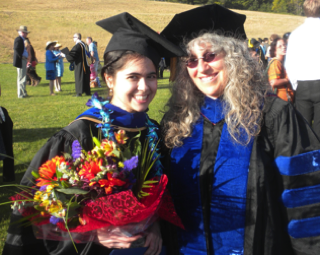Dr. Joy Chittreeya Tansakul
Thesis abstract:
Nitroxides have played a vital role in many areas in chemistry, due to their persistent radical nature, and facile redox properties. In this thesis, nitroxides are used to quench the fluorescence of organic fluorophores and quantum dots, as well as to prepare end-functionalized polymers using nitroxide mediated radical polymerization (NMRP).
Quantum dot (QD) fluorescence is effectively quenched by binding to functionalized nitroxides. The association constants and fluorescence quenching of CdSe QDs with nitroxides bearing a ligand coordinated to the QD surface have been examined using electron paramagnetic resonance and fluorescence spectroscopy. Quenching of QD fluorescence is dependent on the distance between the radical and the QD, and the binding affinity. The quenched fluorescence is restored when the surface-bound nitroxide is converted to a hydroxylamine by a mild reducing agent, or trapped by a carbon radical to form an alkoxyamine. A fluorescence quenching mechanism is proposed.
The phenomenon of fluorescence quenching was extended to organic fluorophores. Nitroxides were synthesized bearing a tethered photosensitive species that undergo photocleavage to form a radical, which is then intramolecularly trapped by the nitroxide. When a fluorescent tag is appended to these nitroxides, the fluorescence is restored upon photoexcitation. A profluorescent nitroxide sensor of mild reductants was also developed, which undergo cyclization upon formation of the hydroxylamine. Unlike existing methodologies, this sensor is non-reversible since it cannot be reoxidized in the presence of oxygen.
Thiol-derivatized N-alkoxyamines, functionalized with a free thiol, disulfide, or trityl-protected thiol group were synthesized and employed in NMRP. Deprotection of the trityl group and mild oxidation provided disulfide linked polystyrene of double the molecular weight. Reduction of this polystyrene, followed by trapping with N-phenylmaleimide (NPM) resulted in a NPM-protected thiol terminated polystyrene with the same molecular weight as prior to oxidation.
Ph.D. 2012: “Nitroxides: Profluorescent Sensors and Functionalized Alkoxyamine Initiators for Nitroxide Mediated Radical Polymerization”
multiyear fellowship from the Royal Thai Government for a Higher Education Strategic Scholarship for Frontier Research Network
B.S. in Chemistry from Prince of Songkla University, Thailand
Masters in Nanoscale Science and Technology from University of Leeds, England
Joy is on the faculty of Organic Chemistry at Prince of Songkla University, Thailand
Publications with the Braslau Group:
C. Tansakul, E. Lilie, E. D. Walter, F. Rivera III, A. Wolcott, J. Z. Zhang, G. L. Millhauser, R. Braslau* “Distance-dependent Fluorescence Quenching and Binding of CdSe Quantum Dots by Functionalized Nitroxide Radicals,” J. Phys. Chem. C, 2010, 114, 7793-7805. doi: 10.1021/jp1005023.
C. Tansakul and R. Braslau “Nitroxides in Synthetic Radical Chemistry” in Encyclopedia of Radicals in Chemistry, Biology and Materials, 2012, C. Chatgilialoglu and A. Studer (eds). John Wiley & Sons Ltd, Chichester, UK, pp 1095-1130.
R. Braslau,* F. Rivera, C. Tansakul “Reversible Crosslinking of Polymers bearing Pendant or Terminal Thiol Groups Prepared by Nitroxide-Mediated Radical Polymerization,” Reactive and Functional Polymers, 2013, 73, 624-632. http://dx.doi.org/10.1016/j.reactfunctpolym.2013.01.009.
C. L. Bailey, J. W. Clary, C. Tansakul, L. Klabunde, C. L. Anderson, A. Y. Joh, A. T. Lill, N. Peer, R. Braslau, and B. Singaram* “Reduction of Weinreb Amides to Aldehydes under Ambient Conditions with Magnesium Borohydride Reagents,” Tetrahedron Letters, 2015, 5, 5725-5733. doi:10.1016/j.tetlet.2014.12.066



